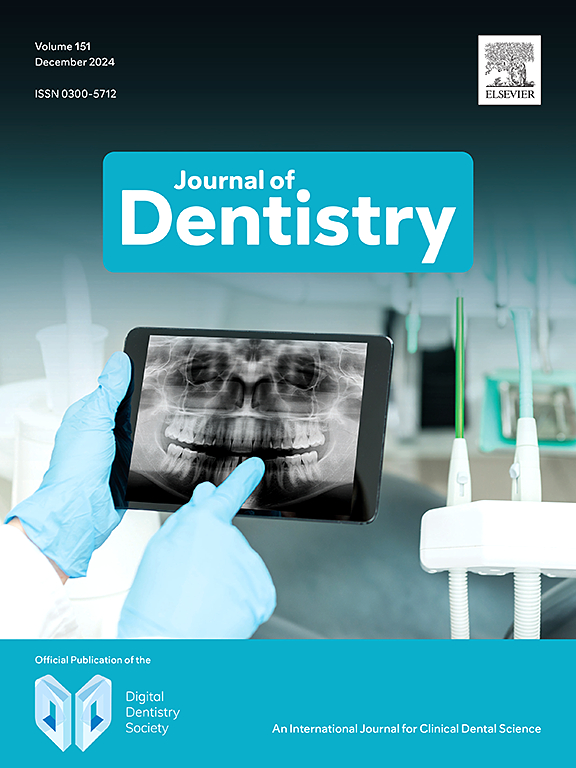不同粘连策略在非龋齿宫颈病变修复中的临床表现:一项为期四年的随机临床试验。
IF 4.8
2区 医学
Q1 DENTISTRY, ORAL SURGERY & MEDICINE
引用次数: 0
摘要
目的:评价4种不同修复方法对宫颈非龋齿病变(ncls)术后4年的保留率及其他临床指标。方法:这是一项前瞻性、随机、双盲、裂口研究,评估了四种不同的黏附策略在非龋齿宫颈病变修复中的应用:不含SBU的黏附修复系统(Scotchbond Universal adhesive /Filtek Z350XT)和选择性牙釉质酸蚀(E-SBU)、树脂改性玻璃离子水门合剂(Vitremer;乙二胺四乙酸作为酸前处理(E-RMGIC)。总共在50名患者中放置了200个修复体。纳入标准为身体健康、对牙科产品无过敏反应、口腔卫生良好。排除标准为怀孕、活动性龋齿、使用脱敏剂/氟化物、正畸器具和严重磨牙。所有修复体在基线和1、2、3和4年后使用改良的美国公共卫生服务(USPHS)标准,对固位、边缘完整性、边缘变色、表面质地、磨损、继发龋齿、解剖形态、表面染色、颜色匹配和牙龈组织边缘适应的炎症进行评分。使用Kruskal-Wallis, Friedman和Wilcoxon (p)。结果:总共有40名患者返回进行随访。与SBU和E-SBU相比,RMGIC和E-RMGIC的表面纹理变化更大。SBU在四年时的保留率比基线时低。与基线相比,四年后观察到所有组的边缘完整性和边缘变色的alpha分数都有所下降。与保留率相关的生存曲线组间无统计学差异(p= 0.315)。结论:离子单体修复的ncls表面光泽比树脂复合修复的降低幅度更大。选择性珐琅蚀刻的使用减少了通用胶粘剂的固位损失。各种粘结策略的初始边缘缺陷均有所增加。临床意义:选择性牙釉质蚀刻对NCCL通用粘接剂的固位损失较小。所有类型的粘合策略在四年后都会出现初始边缘缺陷。本文章由计算机程序翻译,如有差异,请以英文原文为准。
Clinical performance of different adhesion strategies in non-carious cervical lesion restorations: A four-year randomized clinical trial
Objective
To evaluate the retention rate and other clinical criteria of four different restorative techniques for non-carious cervical lesions (NCCLs) after 4 years.
Methods
This is a prospective, randomized, double-blind, and split-mouth study evaluating four different adhesion strategies in non-carious cervical lesion restorations: adhesive restorative system (Scotchbond Universal Adhesive/Filtek Z350XT) without (SBU) and with selective enamel acid-etching (E-SBU), resin-modified glass-ionomer cements (Vitremer; RMGIC), and ethylenediaminetetraacetic as acid pretreatment (E-RMGIC). In total, 200 restorations were placed in 50 patients. Good health, no allergies to dental products, adequate oral hygiene were inclusion criteria. Pregnancy, active caries, use of desensitizers/fluoride, orthodontic appliances, and severe bruxism were exclusion criteria. All restorations were scored regarding retention, marginal integrity, marginal discoloration, surface texture, wear, secondary caries, anatomical form, surface staining, color match, and inflammation of gingival tissue marginal adaptation, using modified United States Public Health Service (USPHS) criteria at baseline and after 1, 2, 3 and 4 years. Kruskal-Wallis, Friedman, and Wilcoxon were used (p < 0.05).
Results
In total, 40 patients returned for the follow-up. RMGIC and E-RMGIC presented more alteration in surface texture than SBU and E-SBU. SBU had lower retention at four years than at baseline. Decreased alpha scores for marginal integrity and marginal discoloration were observed for all groups after four years when compared to baseline. Survival curves, related to retention, presented no statistical differences among groups (p = 0.315).
Conclusions
NCCLs restored with ionomer had more reduction in surface luster than resin composite restorations. The use of selective enamel etching promoted less loss of retention for universal adhesive. The increase of initial marginal defects occurred for all types of adhesion strategies.
Clinical relevance
The use of selective enamel etching cause less loss of retention for universal adhesive used in NCCL. Initial marginal defects occur for all types of adhesion strategies after four years.
求助全文
通过发布文献求助,成功后即可免费获取论文全文。
去求助
来源期刊

Journal of dentistry
医学-牙科与口腔外科
CiteScore
7.30
自引率
11.40%
发文量
349
审稿时长
35 days
期刊介绍:
The Journal of Dentistry has an open access mirror journal The Journal of Dentistry: X, sharing the same aims and scope, editorial team, submission system and rigorous peer review.
The Journal of Dentistry is the leading international dental journal within the field of Restorative Dentistry. Placing an emphasis on publishing novel and high-quality research papers, the Journal aims to influence the practice of dentistry at clinician, research, industry and policy-maker level on an international basis.
Topics covered include the management of dental disease, periodontology, endodontology, operative dentistry, fixed and removable prosthodontics, dental biomaterials science, long-term clinical trials including epidemiology and oral health, technology transfer of new scientific instrumentation or procedures, as well as clinically relevant oral biology and translational research.
The Journal of Dentistry will publish original scientific research papers including short communications. It is also interested in publishing review articles and leaders in themed areas which will be linked to new scientific research. Conference proceedings are also welcome and expressions of interest should be communicated to the Editor.
 求助内容:
求助内容: 应助结果提醒方式:
应助结果提醒方式:


